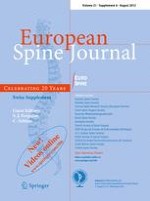Erschienen in:

01.08.2012 | Original Article
Reliability and validity of the cross-culturally adapted Italian version of the Core Outcome Measures Index
verfasst von:
A. F. Mannion, M. Boneschi, M. Teli, A. Luca, F. Zaina, S. Negrini, P. J. Schulz
Erschienen in:
European Spine Journal
|
Sonderheft 6/2012
Einloggen, um Zugang zu erhalten
Abstract
Patient-orientated outcome questionnaires are essential for the assessment of treatment success in spine care. Standardisation of the instruments used is necessary for comparison across studies and in registries. The Core Outcome Measures Index (COMI) is a short, multidimensional outcome instrument validated for patients with spinal disorders and is the recommended outcome instrument in the Spine Society of Europe Spine Tango Registry; currently, no validated Italian version exists. A cross-cultural adaptation of the COMI into Italian was carried out using established guidelines. 96 outpatients with chronic back problems (>3 months) were recruited from five practices in Switzerland and Italy. They completed the newly translated COMI, the Roland Morris disability (RM), adjectival pain rating, WHO Quality of Life (WHOQoL), EuroQoL-5D, and EuroQoL-VAS scales. Reproducibility was assessed in a subgroup of 63 patients who returned a second questionnaire within 1 month and indicated no change in back status on a 5-point Likert-scale transition question. The COMI scores displayed no floor or ceiling effects. On re-test, the responses for each individual domain of the COMI were within one category in 100% patients for “function”, 92% for “symptom-specific well-being”, 100% for “general quality of life”, 90% for “social disability”, and 98% for “work disability”. The intraclass correlation coefficients (ICC2,1) for the COMI back and leg pain items were 0.78 and 0.82, respectively, and for the COMI summary index, 0.92 (95% CI 0.86–0.95); this compared well with 0.84 for RM, 0.87 for WHOQoL, 0.79 for EQ-5D, and 0.77 for EQ-VAS. The standard error of measurement (SEM) for COMI was 0.54 points, giving a ‘‘minimum detectable change’’ for the COMI of 1.5 points. The scores for most of the individual COMI domains and the COMI summary index correlated to the expected extent (0.4–0.8) with the corresponding full-length reference questionnaires (r = 0.45–0.72). The reproducibility of the Italian version of the COMI was comparable to that published for the German and Spanish versions. The COMI scores correlated in the expected manner with existing but considerably longer questionnaires suggesting adequate convergent validity for the COMI. The Italian COMI represents a practical, reliable, and valid tool for use with Italian-speaking patients and will be of value for international studies and surgical registries.